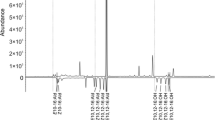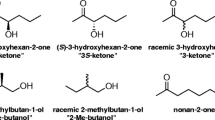Abstract
Behavioral responses of males from three New York races of European corn borer,Ostrinia nubilalis (Hübner), to various suspected sexpheromone-response antagonists were investigated with a flight tunnel protocol. Males from a bivoltine (Z) race and from a univoltine (Z) race utilizing a natural pheromone blend of 98∶2 (Z)-∶(E)-11-tetradecenyl acetates and males from a bivoltine (E) race utilizing a 1∶99 (Z)-∶(E)-11-tetradecenyl acetate ratio were flown to their natural blends and to blends containing 1 % of one of the following additional compounds: Z9–12∶OAc,E9–12∶OAc,Z9–14∶OAc, andE9–14∶OAc. In each race, the added components lowered significantly the number of individuals completing the behavioral sequence. The only exception was bivoltineE males flown to a blend withE9–12∶OAc added. The number completing the sequence in this case was statistically not significantly lower than the number that completed the sequence to the standard blend. In all three races, theZ9–14∶OAc produced the most dramatic reduction in completed flights, and in the univoltineZ race, this added component was significantly more effective in reducing completed flights than any other added component. The response to the Z9–14∶OAc is understandable given recently published findings of an electrophysiological study of single sensilla in the European corn borer.
Similar content being viewed by others
References
Glover, T.J., Tang, X.-H., andRoelofs, W.L. 1987. Sex pheromone blend discrimination by male moths fromE and Z strains of European corn borer.J. Chem. Ecol. 13:143–151.
Grant, A.J., O'connell, R.J., andHammond, A.M. 1987. A comparative study of the neuro-physiological response characteristics of olfactory receptor neurons in two species of noctuid moths, pp. 311–314,in S.D. Roper and J. Atema (eds.). Olfaction and taste IX. New York Academy of Sciences, New York.
Hansson, B.S., Lofstedt, C., andRoelofs, W.L. 1987. Inheritance of olfactory response to sex pheromone components inOstrinia nubilalis.Naturwissenschaften 74:497–499.
Klun, J.A., Chapman, O.L., Mattes, J.C., Wojtkowski, P.W., Beroza, M., andSonnett, P.E. 1973. Insect sex pheromones: Minor amount of opposite geometrical isomer critical to attraction.Science 181:661–663.
Klun, J.A., Maini, S., Chapman, O.L., Lepone, G., andLee, G.-H. 1979. Suppression of male European corn borer sex attraction and precopulatory reactions with (E)-9-tetradecenyl acetate.J. Chem. Ecol. 5:345–352.
Kochansky, J., Cardé, R.T., Liebherr, J., andRoelofs, W.L. 1975. Sex pheromones of the European corn borer,Ostrinia nubilalis (Lepidoptera: Pyralidae), in New York.J. Chem. Ecol. 1:225–231.
Linn, C.E., Jr., Bjostad, L.B., Du, J.W., andRoelofs, W.L. 1984. Redundancy in a chemical signal: Behavioral responses of maleTrichoplusia ni to a six-component sex pheromone blend.J. Chem. Ecol. 10:1635–1658.
Linn, C.E., Jr., Campbell, M.G., andRoelofs, W.L. 1987a. Pheromone components and active spaces: What do moths smell and where do they smell it?Science 237:650–652.
Linn, C.E., Jr., Du, J.W., Hammond, A., andRoelofs, W.L. 1987b. Identification of unique pheromone components for the soybean looper mothPseudoplusia includens.J. Chem. Ecol. 13:1351–1360.
Linn, C.E., Jr., Hammond, A., Du, J., andRoelofs, W.L. 1988. Specificity of male response to multicomponent pheromones in noctuid mothsTrichoplusia ni andPseudoplusia includens.J. Chem. Ecol. 14:47–57.
Marascuilo, L.A., andMcsweeney, M. 1977. Nonparametric and Distribution-Free Methods for the Social Sciences. Brooks/Cole Publishing, Monterey, California, pp. 141–147.
O'connell, R.J., Grant, A.J., Mayer, M.S., andMankin, R.M. 1983. Morphological correlates of differences in pheromone sensitivity in insect sensilla.Science 220:1408–1410.
Reed, G.L., Showers, W.B., Huggas, J.L., andCarter, S.W. 1972. Improved procedures for mass rearing the European corn borer.J. Econ. Entomol. 4:1472–1476.
Roelofs, W.L., Du, J.-W., Tang, X.-H., Robbins, P.S., andEckenrode, C.J. 1985. Three European corn borer populations in New York based on sex pheromones and voltinism.J. Chem. Ecol. 11:829–836.
Siegel, S. 1956. Nonparametric Statistics for the Behavioral Sciences. McGraw-Hill, New York.
Steck, W.F., Underhill, E.W., Chisholm, M.D., andGerber, M.S. 1979. Sex attractant for male alfalfa looper moths,Autographa californica.Environ. Entomol. 8:373–375.
Struble, D.L., Byers, J.R., Mcleod, D.G.R., andAyre, G.L. 1987. Sex pheromone components of an Alberta population of European corn borer,Ostrinia nubilalis (Hbn.) (Lepidoptera: Pyralidae).Can. Entomol. 119:291–299.
Author information
Authors and Affiliations
Rights and permissions
About this article
Cite this article
Glover, T.J., Perez, N. & Roelofs, W.L. Comparative analysis of sex-pheromone-response antagonists in three races of European corn borer. J Chem Ecol 15, 863–873 (1989). https://doi.org/10.1007/BF01015182
Received:
Accepted:
Issue Date:
DOI: https://doi.org/10.1007/BF01015182




